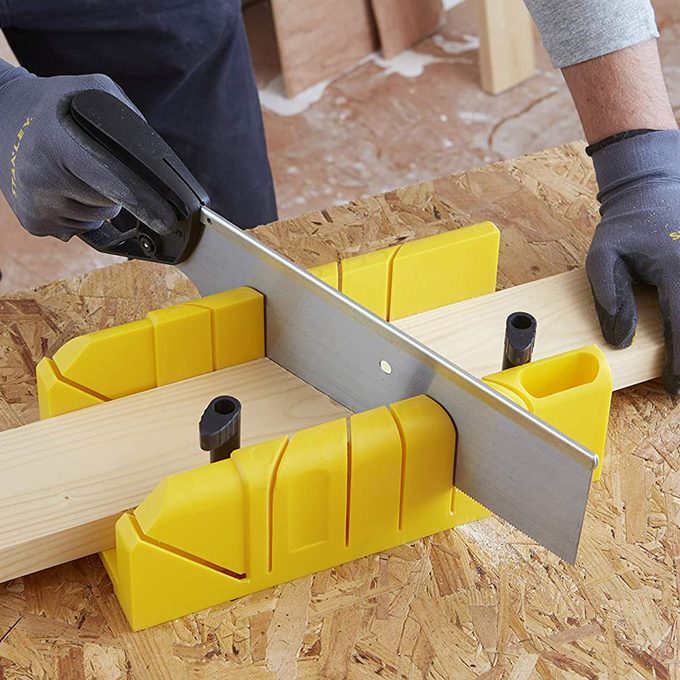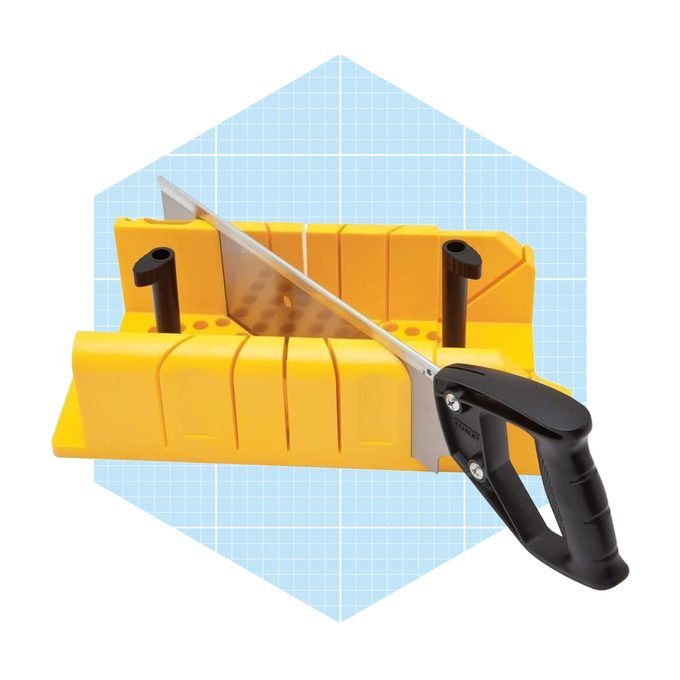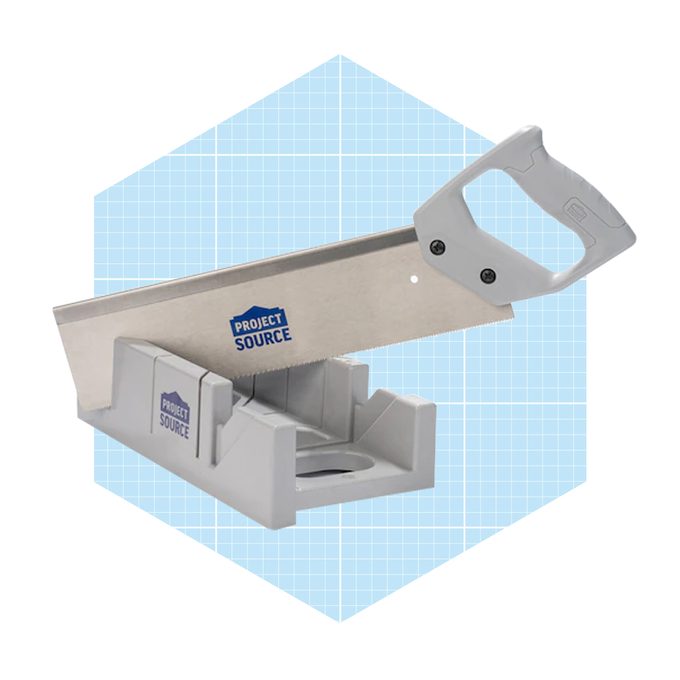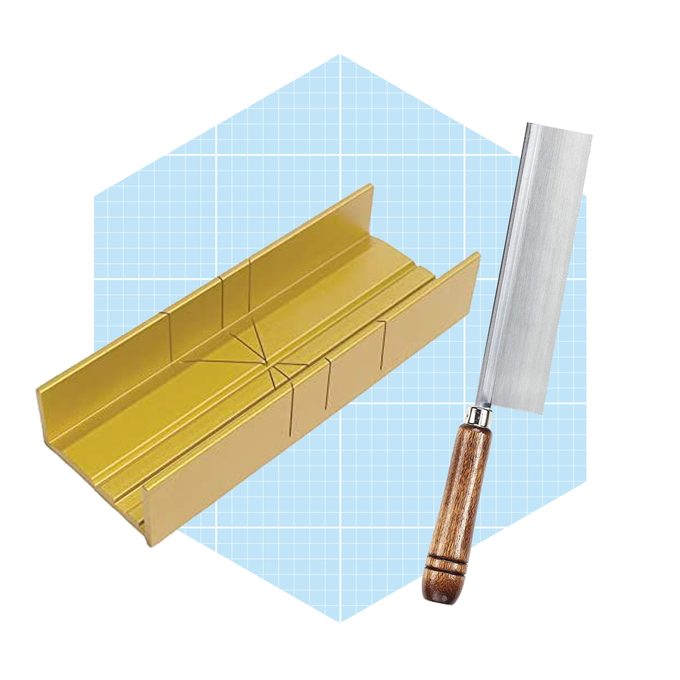

It’s easy to fall into the trap of feeling like you need the latest and greatest power tool for your projects. But just because you can buy a tool doesn’t mean you should.
If you’re cutting wood at an angle for picture framing or interior trim, a miter saw or table saw with a miter gauge can do the job quickly. But these are expensive and take up a lot of workshop space. To cut precision angles without the expense or bulk of a miter saw, a miter box is an affordable, robust option.
On This Page
What Is a Miter Box?
A miter box is the manual equivalent of a miter saw. It’s used to cut wood stock to make miter joints, which connect two pieces of wood at an angle, most often a right angle.
A miter box isn’t really a box. It consists of a stiff, rectangular frame, open on top and both ends, with vertical slots in the walls to guide a saw blade to a precise cut. Some also have a bevel slot, usually set at a 45-degree angle. The open top and ends allow material to be placed inside. Methods of securing the material vary from cam pin systems to clamps.
The box is usually (but not always) sold with an accompanying hand saw, usually a back saw. If you want a high-quality hand saw, you’re better off buying a standalone saw for your miter box.
When To Use a Miter Box
A miter box is a great choice in the following situations:
Cutting small stock
Miter box walls are usually four inches high or less, so they’re meant for cutting smaller items like picture frames, narrow baseboards or other thin material.
Cutting limited angles
If you’re only cutting limited angles (usually 45 degrees), a miter box is a great time saver. If your project requires a greater variety of angles, then look for an adjustable miter box or upgrade to a miter saw. Many home renovations require this level of flexibility. Even corners that appear to be right angles typically aren’t exactly 90 degrees.
Budget-conscious DIY
If you’re on a particularly tight budget, go with a miter box. Most power miter saws cost seven to 10 times more than a miter box.
Tight storage space
A miter box is roughly the same size and weight as a loaf of bread. It can be stored in even the most constrained of workshops.
How To Use a Miter Box

A miter box is simple and intuitive. Once you’ve made a handful of cuts, you’ll be using it like a pro.
- Select the angle: Determine what angle you want to cut. If your project demands an angle not matched by one of the precut slots, consider an open miter box that allows cuts at adjustable angles.
- Secure the material to be cut: This procedure depends on the individual miter box. Many have a honeycomb of perforations on the bottom, with cam pins that fit into place around the material. Others require the user to provide a clamping system. Most back saws that come with miter boxes cut on the pull, so it’s best to secure the material against the front wall or “fence” of the box. If you have a push-cut saw, secure it against the rear fence.
- Secure the box: You don’t want the box sliding around. Many miter boxes come with lips so they can be placed over the edge of a work surface, or ears that can be clamped to a bench top.
- Make the cut: Try to keep the saw perpendicular to the cutting surface to avoid running the blade into the slot walls.
What To Consider When Buying a Miter Box
There are only a few considerations when purchasing a miter box.
- Box material: Whether you opt for plastic, wood or metal mostly depends on personal preferences. Plastic is the most affordable option, but its lighter weight makes it the most likely to shift while cutting.
- Saw quality and proportions: Look for a saw handle that fits comfortably in your hand. Saws with a higher tooth count will cut smoother, while those with a lower tooth count will cut faster.
- Angle options: Most miter boxes come with a few preset angles. Make sure your needs align with these presets. If you’ll be making cuts with unusual angles, look for an adjustable miter box.
Three Top Miter Boxes
Here are three miter boxes to consider:
Best all-around plastic

The Stanley Saw Storage Miter Box comes with a sturdy back saw that securely remains in the box. It also features a honeycomb and cam pin system, and multiple options to secure the box to a work surface. It offers cut slots at 45-, 90- and 22.5-degrees, as well as a 45-degree bevel.
Best budget miter box

The Project Source Miter Box With Saw Set is a great price for a box-and-saw combo. It only has two angle options (45- and 90-degrees) and doesn’t come with a honeycomb and cam pin securing system. But $11 for a box and bundled saw is about as affordable as these tools get.
Best fine-tooth saw and metal miter box

The Olson Zona Miter Box comes with a straight-handle fine kerf saw and offers preset angles of 90, 45, and 60 degrees. The saw cuts wood and soft metals such as copper, with 42 teeth per inch. Note it’s shallower than the previous two models, with only 7/8-inch of cutting depth.
Did you miss our previous article…
https://tophouseimprovement.com/how-to/how-to-care-for-and-grow-pansies/



